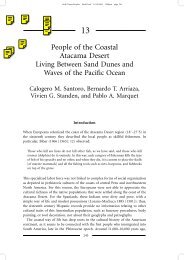Armesto et al LUP 2010.pdf - IEB
Armesto et al LUP 2010.pdf - IEB
Armesto et al LUP 2010.pdf - IEB
Create successful ePaper yourself
Turn your PDF publications into a flip-book with our unique Google optimized e-Paper software.
156 J.J. <strong>Armesto</strong> <strong>et</strong> <strong>al</strong>. / Land Use Policy 27 (2010) 148–160Table 2A framework for climatic and human-driven land cover changes during the last 16,000 years in southern South America, with par<strong>al</strong>lel changes in other temperate regionsof the world. Based on literature cited in the text. Knowledge of climatic and socio-economic drivers of human behavior and policy decisions in response to environment<strong>al</strong>change can be actu<strong>al</strong>ly or potenti<strong>al</strong>ly applicable to understand, anticipate, and prevent future land use trends.Chronology for southernSouth AmericaMain land cover transitionMain climatic orsocio-economic driverPolicy decisions and/orhuman behavior<strong>al</strong> patternsMain transitions and driversin other regions of the worldPostglaci<strong>al</strong> (16,000-12,000)and early Holocene(12,000–6000 BP)Agricultur<strong>al</strong> expansion (5000BP to 1500 AD)Coloni<strong>al</strong> period (1500 to1800s)Preindustri<strong>al</strong>–industri<strong>al</strong>(mid-19th century tomid-20th century)Industri<strong>al</strong>–postindustri<strong>al</strong>(mid-20th century topresent)Rapid forest expansion fromglaci<strong>al</strong> refugia.Decline of forests and loc<strong>al</strong>increase of open areas.Large-sc<strong>al</strong>e deforestation,timber exports to colonies,maximum expansion of openland.Extreme deforestation, andvast soil erosion.Fiber farms expand,homogenization oflandscapes, limited forestrecovery.Climate warming, hunting ofmegafauna, peak in fireincidence.Farming and land clearing byaborigin<strong>al</strong> people in riverbasins.Food demands from NorthAmerica and Europe, wheatcrops. Miners’ rush, fuelwood supply energy tomines, cattle introduced.Burning by s<strong>et</strong>tlers, miners’rush continues, golden age oftimber, fast rates of logging,sawmills, and railway.Public subsidy to plantationforestry, new roads, papermill industry, free tradeagreements signed,introduction of new intensivecrops.None.Shift from nomadic tosedentary communities withstronger links to the land andsoci<strong>al</strong> organization.Protection of areas aroundvillages and water sources.First environment<strong>al</strong>regulations, first public parks.Management of semi-natur<strong>al</strong>matrix, paying forextern<strong>al</strong>ities, need todiversify forest and crops,private conservation.Similar trends of forestrecovery at mid and highlatitudes worldwide.Slush and burn agriculture,spreading of weeds in NorthAmerica, Europe and Asia.Growing deforestation andsoil erosion glob<strong>al</strong>ly. Goldrush in C<strong>al</strong>ifornia andAustr<strong>al</strong>ia.Large-sc<strong>al</strong>e logging of forestsin New England and MidwestUS in late 1800s.Concentration of industri<strong>al</strong>activity in cities. Firstnation<strong>al</strong> parks.Conservation movements,private land protection,abandonment of farmland,forest recovery in Europe andNorth America. Consolidationof urban population,concentration of intensiveagriculture, use of fossil fuels.Fig. 10. Trends of increase in area of avocado plantations and vineyards at southcentr<strong>al</strong>Chile in the past two decades.that led to either loss or gain of veg<strong>et</strong>ation cover. We used thechronosequence of events effecting Chilean forests to illustrat<strong>et</strong>hese transitions. The main drivers of these land cover changes andtheir consequences, as discussed in this paper, are summarized inTable 2. This an<strong>al</strong>ysis offers a broad framework for understandinglandscape change, which could be applied to other regions in Chile(Marqu<strong>et</strong> <strong>et</strong> <strong>al</strong>., 1998; Nuñez and Grosjean, 2003). We offer commentsabout the application of this framework to Latin America andother regions of the world (Table 2).The first great transition, from about 18,000 to 11,500 c<strong>al</strong>. yr.BP, entailed the fast recovery of forests from sm<strong>al</strong>l and sparseglaci<strong>al</strong> refugia to the present extent of 13 million hectares in southernSouth America (Villagrán, 1991, 2001). This trend that wasnearly synchronous with p<strong>al</strong>eoclimate changes recorded in theNorth Atlantic region and other southern hemisphere mid-latituderegions (Webb, 1981; Moreno <strong>et</strong> <strong>al</strong>., 2001). Human impact duringthis postglaci<strong>al</strong> transition is glob<strong>al</strong>ly perceived in the increased fireincidence, shown by charco<strong>al</strong> remains in sediments from lakes insouth-centr<strong>al</strong> Chile and Patagonia (Markgraf and Anderson, 1994;Moreno, 2000; Heusser <strong>et</strong> <strong>al</strong>., 2000; Abarzúa and Moreno, 2008)and reconstructions of fire history from many sites in North America(Russell, 1997; Power <strong>et</strong> <strong>al</strong>., 2008). The dramatic decline of elmin northern Europe starting about 5400 to 4500 c<strong>al</strong>. yr. BP has beenattributed to the use of fire to open land for grazing (Williams,2008). In southern South America, the fire peak coincides with thewarmest and driest period of the entire Holocene (∼12,000 to 6000c<strong>al</strong>. yr. BP) representing the second major change in land cover sinc<strong>et</strong>he postglaci<strong>al</strong> recovery of mid-latitude forests. The last 5000 yearsof the Holocene are characterized by a gradu<strong>al</strong> trend towards diversifyingcrops and significant land clearing, especi<strong>al</strong>ly in the majorriver basins (Dillehay <strong>et</strong> <strong>al</strong>., 2008; Abarzúa, 2009). Trading of goods(e.g., fish, crops) among different <strong>et</strong>hnic groups provided access tonew foods and may have reduced the pressure on the land (Camus,2006). The worldwide process of land cover change largely associatedwith the clearing of land for farming seems to have beenslow at first, but it became accelerated in the past 2000 years,
















